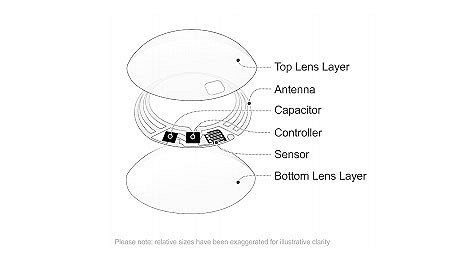
http://www.forbes.com/sites/paulmonckton/2016/04/30/sony-contact-lens-camera/#211000f46b12
You probably think cameras couldn’t get much more convenient than the one built into your smartphone, but Sony has just submitted a patent application for a camera small enough to fit within a contact lens worn directly on the human eyeball.
It’s actually not the first time we’ve seen a contact lens camera device. google GOOGL -2.36% filed a similar patent in 2012, but Sony’s device adds new features and control methods.
Filed under the title “Contact Lens And Storage Medium”, it appears to be, despite its seemingly impossibly small dimensions, a fully-fledged imaging device, incorporating a lens, an imaging sensor, data storage and a wireless communication module. It even offers the possibility of zooming, autofocus and image stabilisation.
The device is operated by detecting deliberate blinking by the user, cleverly filtering out normal blinks, and can be configured to capture one image with each blink, or to continuously capture images to a buffer which is then recorded onto the storage medium when the eye is deliberately closed. It can also detect tilt information during capture and automatically level images for playback. The camera unit itself is placed towards the edge of the eye, away from the pupil, to avoid obscuring the display unit and the normal vision of the user.
Sony’s patent application mentions previous designs detailing the ability to play back images and information to the user via a display unit featuring an integrated lens array built into the contact lens. However, this new filing advances the concept by adding the ability to capture and store images within the lens itself. Power is provided wirelessly and, somewhat scarily if you ask me, through a built in antenna.
Unwanted movements of your eyeball can also be compensated for, thereby removing any resulting blur from the pictures and other sensors are capable of measuring factors such as pressure, infrared and acceleration. The accelerometer could be used to detect when the user is moving at a high speed, so that a fast shutter speed can automatically be selected.
There are plenty of uses for such a device, such as where hands-free or covert operation is required but with the level of image quality possible from a sensor this tiny, we’re probably not talking about fine-art photography. Augmented reality applications similar to those suitable for Google Glass immediately spring to mind, although with the contact lens being essentially invisible, privacy concerns are bound to be raised. The patent also mentions usage cases where the lenses are fitted to animals. The mind boggles at what might be achieved in the future by paparazzi squirrels.
[source: http://www.forbes.com/sites/paulmonckton/2016/04/30/sony-contact-lens-camera/#211000f46b12]
Google is testing a prototype for a smart contact lens that we built to measure glucose in tears continuously using a wireless chip and miniaturized glucose sensor.

http://hypebeast.com/image/2016/04/sony-patents-smart-contact-lens-camera-0.jpg

http://www.dailymail.co.uk/sciencetech/article-2604543/Glass-without-glasses-Google-patents-smart-contact-lens-CAMERA-built-in.html

http://www.telegraph.co.uk/technology/google/10968053/Google-announces-smart-contact-lens-partner.html